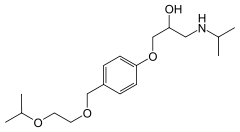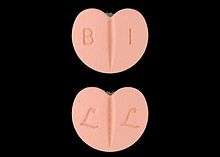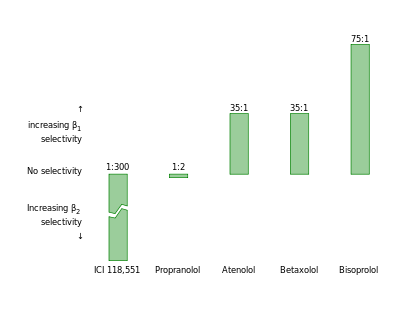Bisoprolol
 | |
| Clinical data | |
|---|---|
| Trade names | Zebeta, Concor, others |
| AHFS/Drugs.com | Monograph |
| MedlinePlus | a693024 |
| License data |
|
| Pregnancy category | |
| Routes of administration | by mouth |
| ATC code | |
| Legal status | |
| Legal status |
|
| Pharmacokinetic data | |
| Bioavailability | >90% |
| Protein binding | 30%[1] |
| Metabolism | 50% liver, CYP2D6, CYP3A4[2] |
| Biological half-life | 10–12 hours[3] |
| Identifiers | |
| |
| CAS Number | |
| PubChem CID | |
| IUPHAR/BPS | |
| DrugBank | |
| ChemSpider | |
| UNII | |
| KEGG | |
| ChEBI | |
| ChEMBL | |
| ECHA InfoCard | 100.108.941 |
| Chemical and physical data | |
| Formula | C18H31NO4 |
| Molar mass | 325.443 g/mol |
| 3D model (JSmol) | |
| Chirality | Racemic mixture |
| |
| |
| (verify) | |
Bisoprolol, marketed under the tradename Zebeta among others, is a medication most commonly used for heart diseases.[4] This specifically includes high blood pressure, chest pain from not enough blood flow to the heart, and heart failure.[4][5] It is taken by mouth.[4]
Common side effects include headache, feeling tired, diarrhea, and swelling in the legs.[4] More severe side effects include worsening asthma, blocking the ability to recognize low blood sugar, and worsening heart failure.[6] There are concerns that use during pregnancy may be harmful to the baby.[7] Bisoprolol is in the Beta blocker family of medications and is of the β1 selective type.[4]
Bisoprolol was patented in 1976 and approved for medical use in 1986.[8] It is on the World Health Organization's List of Essential Medicines, the most effective and safe medicines needed in a health system.[9] Bisoprolol is available as a generic medication.[4] The wholesale cost in the developing world is about 2.98 to 4.94 USD per month.[10] In the United States, as of 2015, it costs about 25 to 50 USD a month.[11]
Medical use

Bisoprolol is beneficial in treatment for high blood pressure (hypertension), reduced blood flow to the heart (cardiac ischemia); congestive heart failure, and preventive treatment before and primary treatment after heart attacks, decreasing the chances of recurrence.[12] Bisoprolol targets hypertension (elevated blood pressure).[13][14] In cardiac ischemia, the drug is used to reduce the activity of the heart muscle, so reduces oxygen and nutrient demand, and reduced blood supply can still transport sufficient amounts of oxygen and nutrients.[15][16][17]
Bisoprolol can be used to treat cardiovascular diseases such as hypertension, coronary heart disease, arrhythmias, ischemic heart diseases, and myocardial infarction after the acute event. Patients with compensated congestive heart failure may be treated with bisoprolol as a comedication (usually with an ACE inhibitor, a diuretic, and a digitalis-glycosid, if indicated). In patients with congestive heart failure, it reduces the need for and the consumption of oxygen of the heart muscle. It is very important to start with low doses, as bisoprolol reduces also the muscular power of the heart, which is an undesired effect in congestive heart failure.
Side effects
Overdose of bisoprolol leads to fatigue, hypotension,[16] low blood sugar,[18][19] bronchospasms, and bradycardia.[16] Bronchospasms and low blood sugar because at high doses drug can be an antagonist for β2 adrenergic receptors located in lung and in liver. Bronchospasm is due to blockage in lungs of β2 receptor and low blood sugar because of decreased stimulation of glycogenolysis and gluconeogenesis in the liver via β2 receptor.[15][16][20]
Cautions
Beta-blockers should generally be avoided in people with a history of asthma or bronchospasm as they may make the disease worse.[6] A beta 1 selective beta blocker like bisoprolol may be tried in those in whom other options are not available.[6]
Mechanism of action
Bisoprolol is cardioprotective because it selectively and competitively blocks catecholamine (adrenalin) stimulation of β1 adrenergic receptors (adrenoreceptors), which are mainly found in the heart muscle cells and heart conduction tissue (cardiospecific), but also found in juxtaglomerular cells in the kidney.[15] Normally, adrenalin and noradrenalin stimulation of the β1 adrenoreceptor activates a signalling cascade (Gs protein and cAMP) which ultimately leads to increased contractility and increased heart rate of the heart muscle and heart pacemaker, respectively.[21] Bisoprolol competitively blocks the activation of this cascade, so decreases the adrenergic tone/stimulation of the heart muscle and pacemaker cells. Decreased adrenergic tone shows less contractility of heart muscle and lowered heart rate of pacemakers.[18][19][22]
Pharmacology and biochemistry

Bisoprolol has both lipid- and water-soluble properties, making it a prime candidate over other β-blockers and even over other β1-blockers, being water-soluble, it has decreased incidence of central nervous system side effects (inability to diffuse into brain) compared to purely lipophilic compounds.[18][22] Bisoprolol has an approximate half-life of 10–12 hours, and when ingested has nearly complete absorption into the blood stream.[18][19] The high absorption is indicative of high bioavailability (approx. 90%).[18][19] When being eliminated, the body evenly distributes it (50–50) between kidney excretion and liver biotransformation (then excreted).[18][19][22] These factors make it a convenient once/day dosage when administered.[18][19]
β1-selectivity
Bisoprolol β1-selectivity is especially important in comparison to other nonselective beta blockers. The effects of the drug are limited to areas containing β1 adrenoreceptors, which is mainly the heart and part of the kidney.[18][22] Bisoprolol minimizes the side effects that might occur from administration of a nonspecific beta blocker where blockage of the other adrenoreceptors (β2, β3, α1, α2) occurs. The other receptors elicit a variety of responses in the body, and their blockage could cause a wide range of reactions, but β1 adrenoreceptors are cardiospecific for the most part, making bisoprolol ideal for treatment of cardiac events.[18][19][22]
Bisoprolol has a higher degree of β1-selectivity compared to other β1-selective β-blockers such as atenolol, metoprolol, and betaxolol.[22][23][24][25][26][27][28][29][30][31] However nebivolol is approximately 3.5 times more β1-selective.[32][33]
Renin-angiotensin system
Bisoprolol inhibits renin secretion by about 65% and tachycardia by about 30%.[23]
Society and culture
Bisoprolol is available as a generic medication and has been approved by the FDA for manufacture by Teva, Mylan, Sandoz, Aurobino, and Unichem.[34]
History
Bisoprolol was patented in 1976 and approved for medical use in 1986.[8] It was approved for medical use in the United States in 1992.[4]
References
- ↑ Bühring KU, Sailer H, Faro HP, Leopold G, Pabst J, Garbe A (1986). "Pharmacokinetics and metabolism of bisoprolol-14C in three animal species and in humans". J. Cardiovasc. Pharmacol. 8 Suppl 11: S21–8. PMID 2439794. doi:10.1097/00005344-198511001-00004.
- ↑ Yuji Horikiri; Takehiko Suzuki; Masakazu Mizobe (March 1998). "Pharmacokinetics and metabolism of bisoprolol enantiomers in humans". Journal of Pharmaceutical Sciences. 87 (3): 289–294. doi:10.1021/js970316d.
- ↑ Leopold G (1986). "Balanced pharmacokinetics and metabolism of bisoprolol". J. Cardiovasc. Pharmacol. 8 Suppl 11: S16–20. PMID 2439789. doi:10.1097/00005344-198511001-00003.
- 1 2 3 4 5 6 7 "Bisoprolol Fumarate". The American Society of Health-System Pharmacists. Retrieved 8 December 2016.
- ↑ "Bisoprolol 2.5mg/5mg/10mg film coated tablet - Summary of Product Characteristics (SPC) - (eMC)". www.medicines.org.uk. 18 February 2014. Retrieved 14 December 2016.
- 1 2 3 "Bisoprolol - FDA prescribing information, side effects and uses". www.drugs.com. Retrieved 14 December 2016.
- ↑ "Bisoprolol (Zebeta) Use During Pregnancy". www.drugs.com. Retrieved 14 December 2016.
- 1 2 Fischer, Janos; Ganellin, C. Robin (2006). Analogue-based Drug Discovery. John Wiley & Sons. p. 461. ISBN 9783527607495.
- ↑ "WHO Model List of Essential Medicines (19th List)" (PDF). World Health Organization. April 2015. Retrieved 8 December 2016.
- ↑ "Bisoprolol". International Drug Price Indicator Guide. Retrieved 8 December 2016.
- ↑ Hamilton, Richart (2015). Tarascon Pocket Pharmacopoeia 2015 Deluxe Lab-Coat Edition. Jones & Bartlett Learning. p. 151. ISBN 9781284057560.
- ↑ Rosenberg, J.; Gustafsson, F. (2008). "Bisoprolol for congestive heart failure". Expert Opinion on Pharmacotherapy. 9 (2): 293–300. PMID 18201151. doi:10.1517/14656566.9.2.293.
- ↑ Amabile, G.; Serradimigni, A. (1987). "Comparison of bisoprolol with nifedipine for treatment of essential hypertension in the elderly: Comparative double-blind trial". European Heart Journal. 8 Suppl M: 65–69. PMID 2967187. doi:10.1093/eurheartj/8.suppl_m.65.
- ↑ Thadani, U. (2004). "Current medical management of chronic stable angina". Journal of cardiovascular pharmacology and therapeutics. 9 Suppl 1: S11–S29; quiz S29–9. PMID 15378129. doi:10.1177/107424840400900103.
- 1 2 3 "A randomized trial of beta-blockade in heart failure. The Cardiac Insufficiency Bisoprolol Study (CIBIS). CIBIS Investigators and Committees". Circulation. 90 (4): 1765–1773. 1994. PMID 7923660. doi:10.1161/01.cir.90.4.1765.
- 1 2 3 4 Konishi, M.; Haraguchi, G.; Kimura, S.; Inagaki, H.; Kawabata, M.; Hachiya, H.; Hirao, K.; Isobe, M. (2010). "Comparative effects of carvedilol vs bisoprolol for severe congestive heart failure". Circulation Journal. 74 (6): 1127–1134. PMID 20354334. doi:10.1253/circj.cj-09-0989.
- ↑ Castagno, D.; Jhund, P. S.; McMurray, J. J. V.; Lewsey, J. D.; Erdmann, E.; Zannad, F.; Remme, W. J.; Lopez-Sendon, J. L.; Lechat, P.; Follath, F.; Höglund, C.; Mareev, V.; Sadowski, Z.; Seabra-Gomes, R. J.; Dargie, H. J. (2010). "Improved survival with bisoprolol in patients with heart failure and renal impairment: An analysis of the cardiac insufficiency bisoprolol study II (CIBIS-II) trial". European Journal of Heart Failure. 12 (6): 607–616. PMID 20354032. doi:10.1093/eurjhf/hfq038.
- 1 2 3 4 5 6 7 8 9 Leopold, G.; Pabst, J.; Ungethüm, W.; Bühring, K. U. (1986). "Basic pharmacokinetics of bisoprolol, a new highly beta 1-selective adrenoceptor antagonist". Journal of clinical pharmacology. 26 (8): 616–621. PMID 2878941. doi:10.1002/j.1552-4604.1986.tb02959.x.
- 1 2 3 4 5 6 7 Leopold G, Ungethüm W, Pabst J, Simane Z, Bühring KU, Wiemann H (September 1986). "Pharmacodynamic profile of bisoprolol, a new beta 1-selective adrenoceptor antagonist". Br J Clin Pharmacol. 22 (3): 293–300. PMC 1401121
 . PMID 2876722. doi:10.1111/j.1365-2125.1986.tb02890.x.
. PMID 2876722. doi:10.1111/j.1365-2125.1986.tb02890.x. - ↑ Hauck, R. W.; Schulz, C.; Emslander, H. P.; Böhm, M. (1994). "Pharmacological actions of the selective and non-selective beta-adrenoceptor antagonists celiprolol, bisoprolol and propranolol on human bronchi". British Journal of Pharmacology. 113 (3): 1043–1049. PMC 1510470
 . PMID 7858847. doi:10.1111/j.1476-5381.1994.tb17098.x.
. PMID 7858847. doi:10.1111/j.1476-5381.1994.tb17098.x. - ↑ Bristow, M. R.; Hershberger, R. E.; Port, J. D.; Minobe, W.; Rasmussen, R. (1989). "Beta 1- and beta 2-adrenergic receptor-mediated adenylate cyclase stimulation in nonfailing and failing human ventricular myocardium". Molecular Pharmacology. 35 (3): 295–303. PMID 2564629.
- 1 2 3 4 5 6 Haeusler G, Schliep HJ, Schelling P, et al. (1986). "High beta 1-selectivity and favourable pharmacokinetics as the outstanding properties of bisoprolol". J. Cardiovasc. Pharmacol. 8 Suppl 11: S2–15. PMID 2439793. doi:10.1097/00005344-198511001-00002.
- 1 2 Harting J, Becker KH, Bergmann R, et al. (February 1986). "Pharmacodynamic profile of the selective beta 1-adrenoceptor antagonist bisoprolol". Arzneimittelforschung. 36 (2): 200–8. PMID 2870720.
- ↑ Kaumann AJ, Lemoine H (October 1985). "Direct labelling of myocardial beta 1-adrenoceptors. Comparison of binding affinity of 3H-(−)-bisoprolol with its blocking potency". Naunyn Schmiedebergs Arch. Pharmacol. 331 (1): 27–39. PMID 2866449. doi:10.1007/bf00498849.
- ↑ Klockow M, Greiner HE, Haase A, Schmitges CJ, Seyfried C (February 1986). "Studies on the receptor profile of bisoprolol". Arzneimittelforschung. 36 (2): 197–200. PMID 2870719.
- ↑ Manalan AS, Besch HR, Watanabe AM (August 1981). "Characterization of [3H](+/-)carazolol binding to beta-adrenergic receptors. Application to study of beta-adrenergic receptor subtypes in canine ventricular myocardium and lung". Circ. Res. 49 (2): 326–36. PMID 6113900. doi:10.1161/01.res.49.2.326.
- ↑ Schliep HJ, Schulze E, Harting J, Haeusler G (April 1986). "Antagonistic effects of bisoprolol on several beta-adrenoceptor-mediated actions in anaesthetized cats". Eur. J. Pharmacol. 123 (2): 253–61. PMID 3011461. doi:10.1016/0014-2999(86)90666-7.
- ↑ Schliep HJ, Harting J (1984). "Beta 1-selectivity of bisoprolol, a new beta-adrenoceptor antagonist, in anesthetized dogs and guinea pigs". J. Cardiovasc. Pharmacol. 6 (6): 1156–60. PMID 6084774. doi:10.1097/00005344-198406060-00024.
- ↑ Schnabel P, Maack C, Mies F, Tyroller S, Scheer A, Böhm M (October 2000). "Binding properties of beta-blockers at recombinant beta1-, beta2-, and beta3-adrenoceptors". J. Cardiovasc. Pharmacol. 36 (4): 466–71. PMID 11026647. doi:10.1097/00005344-200010000-00008.
- ↑ Smith C, Teitler M (April 1999). "Beta-blocker selectivity at cloned human beta 1- and beta 2-adrenergic receptors" (PDF). Cardiovasc Drugs Ther. 13 (2): 123–6. PMID 10372227. doi:10.1023/A:1007784109255.
- ↑ Wellstein A, Palm D, Belz GG (1986). "Affinity and selectivity of beta-adrenoceptor antagonists in vitro". J. Cardiovasc. Pharmacol. 8 Suppl 11: S36–40. PMID 2439796. doi:10.1097/00005344-198511001-00006.
- ↑ Bundkirchen A, Brixius K, Bölck B, Nguyen Q, Schwinger RH (January 2003). "Beta 1-adrenoceptor selectivity of nebivolol and bisoprolol. A comparison of [3H]CGP 12.177 and [125I]iodocyanopindolol binding studies". Eur. J. Pharmacol. 460 (1): 19–26. PMID 12535855. doi:10.1016/S0014-2999(02)02875-3.
- ↑ Nuttall SL, Routledge HC, Kendall MJ (June 2003). "A comparison of the beta1-selectivity of three beta1-selective beta-blockers". J Clin Pharm Ther. 28 (3): 179–86. PMID 12795776. doi:10.1046/j.1365-2710.2003.00477.x.
- ↑ "Drugs@FDA: FDA Approved Drug Products". Retrieved 2013-11-13.